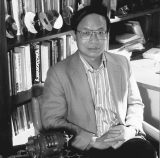|
||||||||||||||||||||||||||||||||||||||||

Sun-Yuan Kung
|
Sun-Yuan KungProfessor of Electrical EngineeringPh.D. 1977, Stanford University
Multimedia technologies will profoundly change the way we access information, and they provide a new opportunity for research interactions among a variety of media such as speech, audio, image, video, text, and graphics. The inevitable merger of the computer industries and information-based consumer and communication industries inevitably introduces new challenges. We investigate various research issues relevant to intelligent multimedia communication applications and implementation technology. We study various adaptive and content-based technologies for MPEG-4 applications, such as compression, indexing, and retrieval of visual information. We look into various areas in video coding and segmentation, including true-motion tracker, global-motion compensated VOP (video-object-plane) coding, video representation, multicue, and multicamera fusion, three-dimensional structure-from-motion analysis, and spatial-temporal interpolation. We study an algorithmic framework that fuses spatial, visual, and motion information from a variety of preprocessing sources: object tracker, motion edge analysis, and so on. Neural networks have become one of the core techniques facilitating intelligent multimedia communication technologies. They are very effective when applied to detection or recognition of high-level features (for example, faces) and multimodality recognition and authentication. These have many critical applications to information representation/retrieval and Internet security, and many focal applications in MPEG-7. For these, we have developed a versatile decision-based neural network that bears a modular structure, while taking advantage of both unsupervised and supervised learning strategies. We look into novel neural network techniques on multisensor classification, hierarchical processing, probabilistic (fuzzy) neural networks, object detection and tracking, and content-based compression and representation. Another major challenge lies in real-time processing speed, a key barrier before online access of massive visual information can become a reality. In fact, it is communication, instead of computing, that will be the processing bottleneck. Thus, the development of the computer technology must be closely intertwined with the information-based consumer and communication technologies. We have studied for a long time the research issues involving design and implementation of VLSI multimedia signal processing circuits and systems. Novel communication and networking technologies will be critical in order for multimedia database systems to support interactive dynamic interfaces. Truly integrated media systems must connect with individual users and content-addressable multimedia databases. This will involve both logical connections to support information-sharing and physical connection via computer networking and data transfer. Our research stresses hierarchical and scalable multimedia architecture platforms, fast architectures by minimizing memory accesses and IO operations, and systematically mapping multimedia algorithms to the new architectures. Ultimately, our research will support development of real-time information-processing systems combining digital video and audio, text, and graphics. |
|||||||||||||||||||||||||||||||||||||||
|
|
|
| Contents copyright © 2002 Princeton University Department of Electrical Engineering All rights reserved. |
|